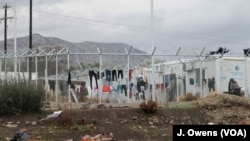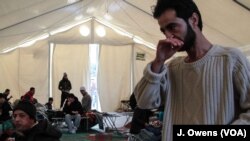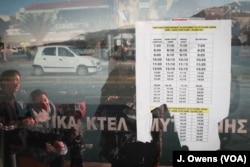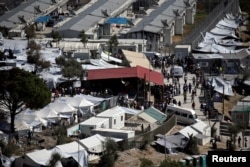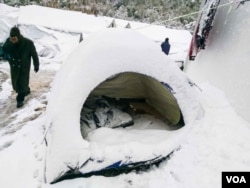It was supposed to be a coordinated demonstration, but when they came to set fire to his tent, Ghebrekristos Tesfay and his friends resisted.
“They did this out of sadness, and told us we must be united together,” said Tesfay, an Eritrean, of the attempts by other refugees in Moria camp on the Greek Island of Lesvos to protest the conditions they were living in.
“But the last time the tents were burnt we got nothing, so we fought back,” he said.
Having struggled with a migrant and refugee population that numbers well over 60,000, the Greek government pledged 2017 would see an improvement in living conditions.
For those like Tesfay, who must endure the everyday desperation of life in the dysfunctional "hot spot" refugee camps of Greece, such improvements can not come soon enough.
IN PICTURES: Life in "hot spot" refugee camps
Heart of the system
During the past year many refugees and migrants have had to endure grim conditions as they remain trapped within Greek borders in the wake of other European countries closing theirs.
Some of the toughest conditions are endured by those living in the country’s so-called "hot spots."
The Greek islands of Lesvos, Samos, Chios, Leros and Kos have been the first point of arrival in Europe for the million-plus refugees that have arrived in Greece from Turkey.
The first of five "hot spots" established in these islands, Moria was opened in October 2015 for the reception, identification and processing of refugees.
Tesfay has been in Moria for a two and a half months, but some of his friends have been here since March.
That was when a deal was struck between the European Union and Turkey that limited movement from the islands to the Greek mainland, pending asylum approval, a deal that came as the number of refugee arrivals to Greece plunged.
The centers were designed to allow a quick asylum process and short stay, but since then the requirements of the deal changed and around 15,000 refugees are stuck on the islands, nearly twice the number that can be housed.
“It’s like a prison here,” said Tesfay, whose homeland is a brutal dictatorship, “and we need our voices heard.”
Tense situation
In November, the two deaths in a gas-stove explosion in Moria prompted riots amid ongoing complaints about living conditions in the camp.
Flare-ups of violence have been frequent among desperate residents trapped in poor conditions and uncertain of their fates, another element of the EU-Turkey deal involves potential deportation back to Turkey.
At Vial, a "hot spot" on Chios, Nigerian Emmanuel Ewemade described his mounting frustration having been stuck on the island for eight months.
“All we are told is wait, wait wait,” he said, adding that fights are a common occurrence in Vial.“This is not a good place to stay, and everyone is angry.”
An assessment by the U.N. body tasked with aiding refugees said congestion coupled with “substandard” conditions in the hot spots “represents a major risk for protection and security, in turn increasing the risk of violence and exploitation.”
Not Greece alone
At the close of 2016, Greek Migration Minister Yannis Mouzalas said conditions were improving for refugees and vowed to address the situation in the coming months.
However, his claim that no refugees were “living in the cold” was starkly contradicted this weekend by images of snow covered tents in Moria camp.
Some argue the European Union must play a greater role in improving the situation for refugees in Greece.
About 7,000 people have been resettled legally from Greece in other EU nations. The EU-Turkey deal calls for 63,300 people on the mainland to be resettled.
Additionally, the European Asylum Support Office told VOA it is now looking to “drastically” increase its presence in the islands to help speed up applications, but is having to recruit more personnel.
Meanwhile, the refugee burden may increase. In December the European Commission recommended the partial reintroduction of the Dublin regulations for Greece, which state refugees and migrants must apply for protection at the first EU country they arrive in. This means that, as of March, some refugees could be sent back to Greece from other EU countries.
“This is the hypocrisy and the irony,” claimed Eva Cossé of Human Rights Watch. “The EU wants to resume Dublin returns [of refugees] to Greece, but conditions in Greece are already poor because of the EU’s policies,” she added.
In Moria, even if things do speed up, there is no guarantee Tesfay’s asylum application will be accepted. But though he is desperate to remain in Europe, the thing he yearns for most is clarity.
“If they make a decision it’s good, whether they reject or accept me,” he explained. “It’s the staying here with no solution that is not fair.”




